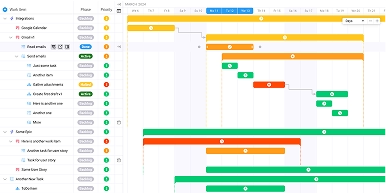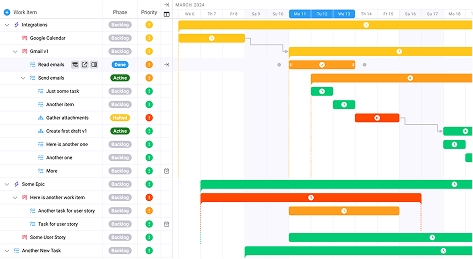
Top 50 Project Management Statistics For 2025
Key takeaways:
Project management continues to evolve rapidly as organizations face increasing complexity, digital transformation demands, and changing workforce expectations. Understanding the latest project management statistics provides valuable insights for organizations looking to improve their project success rates, optimize resources, and stay competitive in 2025. These data-driven insights reveal key trends shaping the industry, from AI adoption and remote work patterns to skill gaps and certification impacts.
Whether you’re a project manager, executive, or business leader, these 50 carefully researched statistics will help you benchmark your organization’s performance and make informed decisions about project management strategies, tools, and investments.
Project Success and Failure Statistics
1. Only 35% of projects are completed successfully
According to Harvard Business Review research, only 35% of projects today are completed successfully. This disappointing rate highlights the ongoing challenges in project delivery and the need for improved project management practices.
2. 73.8% is the average project performance rate
PMI’s 2024 research shows that the average project performance rate across organizations is 73.8%, indicating that while most projects deliver some value, there’s significant room for improvement.
3. Projects are 2.5 times more successful when PM practices are implemented
Organizations with structured project management approaches see dramatically better outcomes, with projects being 2.5 times more successful when proper PM frameworks are in place.
4. Agile projects have a 64% success rate
Research from the Standish Group shows that Agile projects achieve a 64% success rate, significantly higher than traditional waterfall approaches.
5. Waterfall projects have a 49% success rate
In contrast to Agile, waterfall projects achieve only a 49% success rate, demonstrating the effectiveness of more adaptive project management methodologies.
6. 36% of organizations fully realize project benefits
Wellingtone’s 2024 research reveals that only 36% of organizations fully realize the benefits their projects were designed to achieve, highlighting the importance of benefits realization management.
7. 34% of organizations complete projects on time
The same Wellingtone study found that only 34% of organizations mostly or always complete projects on time, indicating widespread challenges with schedule management.
8. 34% of organizations complete projects on budget
Similarly, just 34% of organizations consistently complete projects within budget, showing that cost control remains a significant challenge.
9. The average project cost overrun is 27%
Project cost overruns average 27% across all industries, representing millions of dollars in wasted resources annually.
10. $1 million is wasted every 20 seconds due to poor project management
Organizations collectively waste $1 million every 20 seconds due to poor project management practices, equating to approximately $2 trillion annually.
Workforce and Employment Statistics
11. 947,630 project management specialists are employed in the US
As of May 2023, the U.S. Bureau of Labor Statistics reports 947,630 project management specialists are employed in the United States.
12. Project manager employment will grow 7% from 2023 to 2033
The BLS projects 7% employment growth for project management specialists from 2023 to 2033, faster than the average for all occupations.
13. 77,000 job openings are projected each year
About 77,000 openings for project management specialists are projected each year on average over the decade.
14. 25 million new project management professionals will be needed by 2030
PMI research indicates that 25 million new project management professionals will be required globally by 2030 due to increasing demand.
15. The talent demand gap is largest in China at 13.6 million by 2035
China faces the largest project management talent gap, with an expected shortage of up to 13.6 million professionals by 2035.
16. 59% of project managers run 2-5 projects simultaneously
Research shows that 59% of project managers handle 2-5 projects at the same time, while only 15% manage a single project.
17. 15% of project managers handle more than 10 projects at once
At the other extreme, 15% of project managers manage more than 10 projects simultaneously, indicating significant workload challenges.
18. The average age of project managers is 42.4 years
Studies show the average project manager age is 42.4 years, with peaks at 27.4 and 54.6 years, highlighting a generational gap in the industry.
Salary and Compensation Statistics
19. The median annual wage for project managers is $100,750
The U.S. Bureau of Labor Statistics reports a median annual wage of $100,750 for project management specialists as of May 2024.
20. Project manager salary range is $104,000 to $183,000 per year
Current market data shows project manager salaries range from $104,000 to $183,000 annually, depending on experience and industry.
21. The median total pay for project managers is $136,000
Including base salary and additional compensation, the median total pay for project managers reaches $136,000 per year.
22. Technology industry offers the highest project manager salaries
The technology sector provides the highest compensation for project managers compared to other industries.
23. PMP certification increases salary by 23%
Project managers with PMP certification earn 23% more compared to those without certification, demonstrating the value of professional credentials.
24. 66% of project managers reported salary increases in 2023
A significant majority of project managers saw compensation growth, with 66% reporting salary increases in 2023.
25. PMPs earn an average of $130,000 vs $90,000 for non-PMPs
The salary gap between certified and non-certified professionals is substantial, with PMPs earning $130,000 annually compared to $90,000 for non-PMPs.
Technology and Software Statistics
26. The project management software market will reach $15.06 billion by 2030
Market research indicates the PM software market will grow to $15.06 billion by 2030, with a compound annual growth rate of 10.68%.
27. Only 23% of organizations use project management software
Despite the market growth, only 23% of organizations currently use dedicated PM software, indicating significant adoption potential.
28. 77% of high-performing projects use project management software
While overall adoption is low, 77% of high-performing projects utilize PM software, demonstrating its effectiveness for successful project delivery.
29. Project management software saves employees 498 hours per year
On average, PM software helps employees save 498 hours annually, representing significant productivity gains.
30. 82% of companies use work and project management software for organizational efficiency
Recent research shows 82% of companies use PM software to drive organizational efficiencies and improve collaboration.
31. AI in project management will grow from $3.08 billion to $7.4 billion by 2029
The AI project management market is projected to grow from $3.08 billion in 2024 to $7.4 billion by 2029, with a CAGR of 19.9%.
32. 80% of project management tasks will be eliminated by AI by 2030
Gartner predicts that 80% of current project management tasks will be eliminated by 2030 as artificial intelligence takes over traditional PM functions.
33. 90% of organizations are undergoing digital transformation
McKinsey research shows 90% of organizations are currently undergoing some type of digital transformation, driving demand for project management capabilities.
Training and Skills Statistics
34. Only 47% of projects are run by professional project managers
Wellingtone research reveals that only 47% of projects are handled by professional project managers, with the majority led by non-certified individuals.
35. Only 45% of organizations provide accredited PM training
Despite the need for skilled professionals, only 45% of organizations offer accredited project management training to their employees.
36. 71% of companies believe employees need more PM skills
A significant majority of organizations recognize skill gaps, with 71% believing their employees need more project management skills.
37. 1.58 million professionals are PMP-certified worldwide
Currently, 1.58 million professionals hold PMP certification across 211 countries, representing the global standard for project management competency.
38. The PMP pass rate is less than 70%
Despite its value, the PMP exam has a pass rate below 70%, indicating the rigor of the certification process.
39. 72% of organizations report higher success rates when prioritizing soft skills
Companies that emphasize soft skills development see 72% project success rates compared to 65% for those that don’t prioritize these capabilities.
Remote Work and Team Composition Statistics
40. 61% of project managers work remotely at least part-time
PMI’s 2024 research shows that 61% of project management professionals now work remotely at least some of the time.
41. Only 3% of construction project managers work fully remotely
Industry variations are significant, with only 3% of construction project managers working in fully remote roles, compared to higher percentages in other sectors.
42. Remote, hybrid, and in-person teams have similar performance rates
Surprisingly, remote (73.2%), hybrid (73.4%), and in-person (74.6%) project teams show nearly identical performance rates.
43. 39% of project teams consist of 6-10 people
Research indicates that 39% of project teams are composed of 6-10 members, which is considered an optimal size for effective collaboration.
44. 70% of project teams have 10 or fewer members
The vast majority of project teams remain relatively small, with 70% having 10 or fewer members, facilitating better communication and coordination.
Organizational Maturity and PMO Statistics
45. 82% of organizations have at least one PMO
Wellingtone’s research shows that 82% of organizations now have at least one Project Management Office, indicating widespread recognition of PM value.
46. 72% believe their PMO scope will increase in the future
A significant majority of organizations see expanding roles for their PMOs, with 72% believing the scope and responsibilities will grow.
47. Only 37% of organizations are satisfied with their PM maturity
Despite PMO prevalence, only 37% of organizations are satisfied with their current level of project management maturity.
48. 42% of respondents spend one or more days manually collating reports
Administrative burden remains high, with 42% of project professionals spending full days manually creating project reports.
Industry-Specific and Methodology Statistics
49. 60% of project managers use hybrid delivery approaches
Hybrid project delivery methods, combining Waterfall and Agile approaches, are now used by 60% of project managers across all experience levels.
50. 48% of organizations prioritize ESG projects for technology teams
Environmental, Social, and Governance initiatives are gaining importance, with 48% of organizations identifying ESG projects as a top priority for their technology teams in the next two years.
Conclusion
These 50 project management statistics for 2025 reveal a field in transition, balancing traditional challenges with emerging opportunities. While project success rates remain concerning, organizations that invest in proper project management practices, training, and technology see significantly better outcomes. The growing importance of AI, the continued evolution of remote work, and the increasing recognition of soft skills all point to a future where project management becomes more strategic, technology-enabled, and human-centered.
Success in 2025 will require organizations to address skill gaps, embrace new technologies, and evolve their project management practices to meet the demands of an increasingly complex business environment. The data clearly shows that investment in project management capabilities—whether through training, certification, technology, or organizational structure—delivers measurable returns in project success rates and business value.









